Main deities and the cosmogonical theory
Hinduism is one of the most extraordinary religions of the world where
polytheism reaches the unbelievable degree. The innumerous number of gods and
goddesses decorate niches of the pantheon.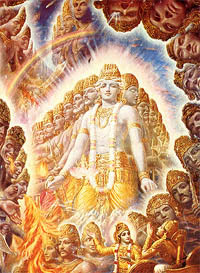
There are three supreme deities: Brahma, Vishnu and Shiva.
They constitute the concept of Trimurti i.e. the triple image which unites
Brahma the Creator, Vishnu the Almighty and Shiva the Destroyer.
Besides the three Supreme Deities the Hindus also worship a great number of
other gods, the most known of them are the following:
Indra: the god of war, the king of demigods, the ruler of Amaravati, one of the
lower skies. He is considered to guard the Eastern part of the world.
Varuna: the all-seeing god of the Vedas who descended from his celestial palace
to become the god of waters. At the same time he is the keeper of the Western
part of the Universe.
Yama: the guardian of the Southern part of the world, the god of death who
reigns in the Purgatory where sinners suffer until the next birth.
Kubera: the god of precious metals, stones, minerals and wealth in general, the
lord of the Northern part of the world. His residence is the wonderful town of
Alaka not far from the mountain Kaylasa.
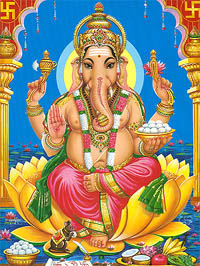 Innumerous armies of dwarves (guhyakas)
and mountain spirits (yakshas) are subordinate to him. Innumerous armies of dwarves (guhyakas)
and mountain spirits (yakshas) are subordinate to him.
Ganesha (Ganapati): the god with the elephant head, Shiva and Parvati's second
son, the leader of ganas (demigods, Shiva's servants). He is The Obstacles
Remover and the patron of all who goes in for different studies. He is the most
favorite deity among the Hindus and is frequently portrayed dancing. His
attributes are one broken tusk and a fat abdomen; he solemnly sits upon a rat.
Hanuman:the monkey god, son of Vayu (the god of wind), friend and true servant
of Rama. In his honor monkeys are considered sacred.
Kama: the Indian god of love. Just like his European colleague he is portrayed
as a handsome youth armed with a bow and arrows with a slight difference that
his bow is made of sugarcane and flowers are his arrows. He has apsaras (nymphs)
in his service.
Besides, all gods and demigods had wives who as a rule wore the names similar to
the male names only with female endings, for instance Indrani.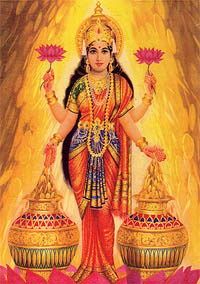
Similar to the three Supreme Deities, Brahma, Vishnu and Shiva's wives are the
Supreme among the great number of female deities of the Indian pantheon and are
highly revered by the Hindus.
Sarasvati: Lord Brahma's wife, the patroness of art, music and literature. She
is portrayed as a young beautiful white-skinned woman with a vina (an Indian
lute) and a book in her hand; she is escorted by a swan. According to a legend
it was Sarasvati who invented Sanskrit.
Lakshmi: the goddess of luck and prosperity, Lord Vishnu's wife. According to a
legend she appeared from the waters of the churned Causal Ocean. She is usually
portrayed as a wonderful woman in her prime who sits or stands on a lotus, often
with a lotus in her hand. They believe that as Vishnu's wife she becomes a wife
of his every incarnation. Thus she is worshipped as Goddess Sita, Rama's spouse
(see below); Rukmini, the first Krishna's queen, and Radha, Lord Krishna's
eternal sweetheart.
Parvati: Lord Shiva's wife in her benevolent aspect. In her awesome aspect she
is worshipped as Durga or Kali. In her hostile aspect Parvati is portrayed as a
terrible multi-handed witch armed with various weapons, with her fangs bared,
with a bloody tongue and a necklace of skulls around her neck. VISHNU
Vishnu is usually portrayed as a four-handed man with dark blue skin and a crown
on his head who holds symbolical attributes in his hands: a shell, a disc
sudarshanu, a rod and a lotus. There is a sacred
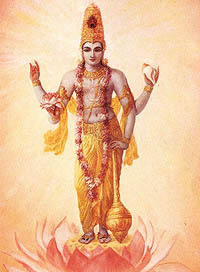 precious stone kaustubha on his
neck. He rides Garuda, a gigantic eagle with a semi-human face. The Hindus
worship Vishnu as "an all-embracing deity" meaning that all other gods are
either his emanations or reflect his separate aspects. precious stone kaustubha on his
neck. He rides Garuda, a gigantic eagle with a semi-human face. The Hindus
worship Vishnu as "an all-embracing deity" meaning that all other gods are
either his emanations or reflect his separate aspects.
According to a Hindu cosmogonical myth Vishnu is the eternal ruler on the
planets of "the spiritual sky" - Vaikunthah (here he is called Narayana). A
spiritual cloud sometimes darkens the edge of the spiritual sky brahmajiyoti.
The darkened part is called mahat-tattva.
Then Lord Narayana assumes the shape of Maha-Vishnu and lies on the waters of
the Causal Ocean. At the same time he stays in a meditation sleep yoga-nidra.
The moment he exhales the innumerous numbers of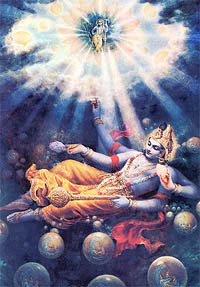 universes come out of the pores
of his body. They float on the surface of the Causal Ocean like bubbles in foam.
All these universes only exist during a single Visnu's exhalation. universes come out of the pores
of his body. They float on the surface of the Causal Ocean like bubbles in foam.
All these universes only exist during a single Visnu's exhalation.
The same Maha-Vishnu enters each of these universes as Garbhodakashayi-Visnu and
in Garbha Ocean he lies upon serpent Shesha who is also one of the Narayana's
aspects.
Out of Garbhodakashayi-Visnu's omphalos a stem of lotus grows up and on this
lotus Brahma, the Lord of the specific Universe, is born. Out of his mind and
body Brahma creates various forms of living creatures which give the Individual
Souls (atme) the opportunity to become apparent in the material world. He also
creates the Sun, the Moon and all the planets of
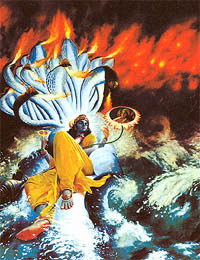 "the material sky" and all the
demigods who rule these planets i.e. in fact he creates his own Universe. "the material sky" and all the
demigods who rule these planets i.e. in fact he creates his own Universe.
The life time of a universe equals Brahma's life period and makes up 100 "Brahma
years" that exactly equals Maha-Vishnu's length of exhalation. When Maha-Vishnu
inhales, all the myriads of universes each one with its own Brahma, return into
the non-developed state and wait for the new Maha-Vishnu's exhalation.
In Hinduism the main cosmological cycle is kalpa, "a day of Brahma" that
consists of 14 manvantaras or secondary cycles with duration of 306 720 thousand
years each with big intervals between them. 360 of such days and nights make up
"a year of Brahma". Every "cosmic day" Brahma creates the Universe and every "cosmic
night" he absorbs it; and while he sleeps the whole universe stays in his body
as a pure potency. Every manvantara contains 71 mahayugas and each mahayuga in
its turn is divided into four yugas (eras): Krita (other name Satya), Treta,
Dvapara and Kali. Their duration equals respectively:
Satya Yuga - 1 728 thousand human years
Treta Yuga - 1 296 thousand years
Dvapara Yuga - 864 thousand years
Kali Yuga - 432 thousand years
Every Yuga is the further decline of religiousness, morals, power, growth and
duration of human life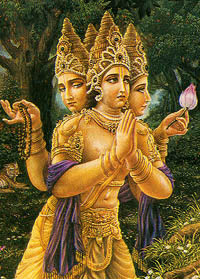 and his happiness in comparison with the previous Yugas.
It is believed we live in the era of Kali Yuga that began 5000 years ago. and his happiness in comparison with the previous Yugas.
It is believed we live in the era of Kali Yuga that began 5000 years ago.
Thus if one counts up the whole life time of a single Universe it will equal 311
040 000 million of human years.
While the whole multitude of universes stays revealed, the Initial Vishnu
watches how the things go in each of them and from time to time he incarnates in
this or that form entirely or partially to introduce the proper order. According
to the most spread classification there has been 10 Vishnu's avatars (incarnations)
on the Earth.
1. Fish (matsya). When the Earth was under the waters of the Flood, Vishnu
assumed the aspect of a fish which was the first to warn Manu (the forefather of
the mankind, Brahma's son) of the coming danger. Then it took Manu, his family
and seven sages (rishis) out of the Flood on a ship tied to a horn on its head.
2. Turtle(kurma). Many divine treasures were lost during the flood including
ambrosia (amrita) that helped gods to preserve their eternal youth. Vishnu
assumed the aspect of a gigantic turtle and went to the bottom of the cosmic
ocean. The gods placed mountain Mandara on its back and wrapped the divine
serpent Vasuka around the mountain. Then they pulled the serpent and thus
untwisted the mountain shaking the ocean up the way an ordinary Indian milkman
churns butter. Amrita and many other treasures including goddess Lakshmi came to
the surface of the foamed ocean.
3. Wild boar(varaha). Demon Hiranyaksha again immersed the Earth into the depths
of the cosmic ocean. Vishnu assumed the image of a gigantic wild boar, killed
the demon and put the Earth back in its place by raising it on its fang.
4. Lion Man(narasimha). Another demon Hiranyakashipu received the magic ability
to become invulnerable as a gift from Brahma. Neither animal nor man, nor god
could kill him neither by day nor by night. Using his safety he started to
pursue gods and men and even his pious son Prahlada. Then Prahlada turned to
Vishnu for help. At sunset i.e. neither by day nor by night the god suddenly
appeared out of a column in the demon's palace and killed the demon in the image
of half-man and half-lion.
5. Dwarf (vamana). Demon Bali seized power over the world and after performing a
number of ascetic feats he acquired the supernatural might and even started to
threaten gods. Vishnu appeared before him in the image of a dwarf and asked to
give him as a present as much land as he could measure in three steps. When the
present was promised the god turned into a giant and made two steps which
covered the earth, the sky and the space between them. But he generously
abstained from the third step leaving the underworld in the demon's domain.
6. Parashurama ("Rama with an axe"). Vishnu assumed a human image as a Brahman
Jamadagni's son.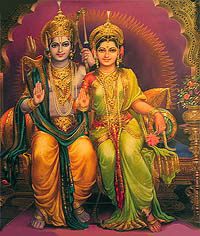 When wicked tsar Kartavirya robbed his father, Parashurama
killed him. Kartavirya's sons in their turn killed Jamadagni, after that angry
Parashurama 21 times exterminated all the men from the kshatriy(warriors) estate. When wicked tsar Kartavirya robbed his father, Parashurama
killed him. Kartavirya's sons in their turn killed Jamadagni, after that angry
Parashurama 21 times exterminated all the men from the kshatriy(warriors) estate.
7. Rama, the prince of Ayodhy, a hero of the epic drama "Ramayana". Vishna
assumed his image to save the world from the oppressions of demon Ravana. Rama
is usually portrayed as a man with dark skin often armed with a bow and arrows.
He is followed by his loving spouse Sita, the embodiment of feminine loyalty,
his three devoted brothers: Lakshmana, Bharata and Shatrughna, and by Hanuman,
the king of monkeys, his loyal friend and companion-in-arms. Rama is revered as
the embodiment of an ideal husband, commander and a monarch.
8. Krishna, the most significant of Vishnu's incarnations. The stories from the
life of this deity are
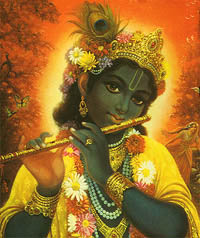 most often referred to in dance. The most favorite scenes
are his child's roguery as for instance stealing butter from Yashoda (his foster
mother) or his love affairs withgopis (shepherdesses) among whom the beauty
Radha was the most beloved. most often referred to in dance. The most favorite scenes
are his child's roguery as for instance stealing butter from Yashoda (his foster
mother) or his love affairs withgopis (shepherdesses) among whom the beauty
Radha was the most beloved.
The more detailed description of Krishna's life can be found in the most famous
epic work Mahabharata.
In short his story is the following. Krishna was born in Mathur in the tribe of
yadavas. His father was Vasudeva, his mother - Devaki, the cousin sister of king
Kansa who reigned at that time. There was a prophecy that Kansa would perish
from the hand of Devaki's eighth son, that's why he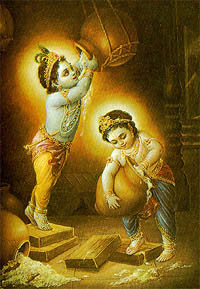 intended to destroy all her
children. But Krishna and his elder brother Balarama escaped the massacre. They
were adopted and brought up by a shepherd Nanda and his wife Yashoda from
Vrindavana. On knowing that the brothers escaped the death prepared for them,
Kansa made multiple attempts to destroy the children. But as the incarnation of
the God, Krishna worked a great number of wonders and performed feats: he would
kill demons sent by Kansa, would cover the dwellers of Vrindavana from the storm
by raising the mountain Govardhana on his little finger over their heads etc.
When he was free from performing feats he grazed cows, played the flute for
gopies and gave himself to his child's roguery. intended to destroy all her
children. But Krishna and his elder brother Balarama escaped the massacre. They
were adopted and brought up by a shepherd Nanda and his wife Yashoda from
Vrindavana. On knowing that the brothers escaped the death prepared for them,
Kansa made multiple attempts to destroy the children. But as the incarnation of
the God, Krishna worked a great number of wonders and performed feats: he would
kill demons sent by Kansa, would cover the dwellers of Vrindavana from the storm
by raising the mountain Govardhana on his little finger over their heads etc.
When he was free from performing feats he grazed cows, played the flute for
gopies and gave himself to his child's roguery.
When he grew up and bid farewell to his idyllic shepherd life he headed for
Mathura to fight the malevolent cousin of his mother. He killed Kansa and became
the ruler of the kingdom of Mathura; but being pressed
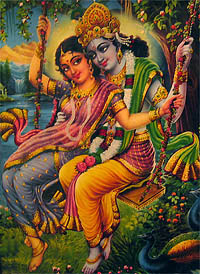 by the ruler Magadhi,
Kansa's father-in-law from the one side, and from the other side by the nameless
king of yavanas from the north-west, he left the kingdom and established a new
capital in Dvarak in Saurashtra. There he married Rukmini and made her his main
wife among his 16,108 wives who gave birth to his 180,000 sons. In the main "Mahabharata"
story throughout the whole history of the fight among royal clans he appears as
a devoted friend and councilor of the five Pandavas brothers and before the
battle at Kurukshetra which is the culmination of "Mahabharata" while addressing
to one of his brothers Arjuna, he pronounced his great sermon stated in "Bhagavadgita". by the ruler Magadhi,
Kansa's father-in-law from the one side, and from the other side by the nameless
king of yavanas from the north-west, he left the kingdom and established a new
capital in Dvarak in Saurashtra. There he married Rukmini and made her his main
wife among his 16,108 wives who gave birth to his 180,000 sons. In the main "Mahabharata"
story throughout the whole history of the fight among royal clans he appears as
a devoted friend and councilor of the five Pandavas brothers and before the
battle at Kurukshetra which is the culmination of "Mahabharata" while addressing
to one of his brothers Arjuna, he pronounced his great sermon stated in "Bhagavadgita".
9. Buddha, the latest Vishnu's incarnation in the past. According to "Gitagovinda"
written by the great poet Jayadeva, Vishnu assumed the image of Buddha out of
compassion to animals in order to put an end to the bloody offerings.
10. Kalki - the future incarnation. The Hindus believe that in the end of our
morbid era Vishnu will appear as a man riding on a white horse with a blazing
sword in his hand. He will condemn sinners, reward the virtuous ones and revive
Satya Yuga ("the golden age").
SHIVA
In the Hindus' view all classical arts are inseparably linked with the divinity.
They believe that Shiva is the source of dance - Nataraja. He dances and
destroys the Universe when the due time comes. But Shiva is also a great ascetic.
He sits immersed in meditation on the mountain Kaylasa in the Himalayas. There
is a legend that Parvati had to follow Shiva's example and became a hermit so
that Shiva took notice of her and married her.
In his Nataraja aspect Shiva is usually portrayed four-handed. In his upper left
hand he holds Damara, a small drum which he uses while dancing Tandava.
Vibrations of vital force come from Damara that puts the first step towards the
Evolution of the Universe. Besides, the birth of the initial sound "OM" is
identified with this drum. The other left hand lowered in the direction of the
toes of a raised leg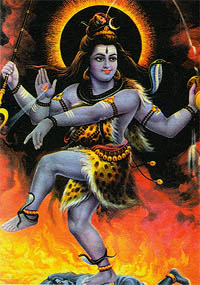 embodies liberation and deliverance. embodies liberation and deliverance.
The upper right hand holds a plate with fire or a trident, the symbol of
purification and destruction, and the lower right hand with stretched fingers
and omkara on the palm symbolizes protection.
The right foot that treads on a dwarf breaks the chains which embrace a soul and
lead it into the world of ignorance and illusion. The raised left leg is the
symbol of liberation from Samsara (chain of reincarnations).
There is an image of Shiva with loose and flying hair decorated with stars. This
is the example of Rhythm in space. Two eyes of Shiva are the Sun and the Moon,
and "the third eye" is the symbol of his supreme wisdom and insight. The three
eyes altogether embody the Past, the Present and the Future.
Shiva is sometimes portrayed as Ardhanarishvara with one part of the figure
being the male aspect the other is the female aspect. This is the symbol of the
god's unity with his shakti (inner energy).
The river Ganga streaming out of his head confirms his immortality. And, finally,
Shiva's dance over the prostrate dwarf symbolizes the complete victory over the
evil in the whole world.
Generally speaking Shiva's dance is known as Tandava and takes one of the main
places in Indian mythology. They believe that Shiva performed 108 kinds of
Tandava though only 64 of them have a detailed description in literature.
The seven basic types of Tandava are called respectively: Kalika, Gauri, Sandhya,
Samhara, Tripura, Urdhava and Ananda.
Shiva performed the most famous Ananda Tandava in the place Tillai (modern
Chitambaram, 150 miles far from Madras).
The story is the following. Shiva learned that several thousands of heretics
settled down in the forest not far from Tillai. Having decided to finish with
them he headed there followed by Vishnu who assumed the image of a beautiful
woman as a blind. But rishis (sages) sensed the danger and immediately prepared
for defense. They lit sacrificial bonfires and started to read magic spells that
resulted in the appearance of a tiger, a serpent and a dwarf.
Shiva neutralized the tiger and the serpent by putting them on as ornaments and
started to dance on the dwarf. The heretics realized the uselessness of their
efforts and when Shiva opened his third eye they prostrated themselves as one
before him. Among those who saw dancing Shiva was Adi Shesha, a thousand-headed
serpent upon which Vishnu lies. He was so enchanted by what he saw that he
appealed to Shiva with a prayer to give him the opportunity of admiring the
dance once more. Shiva told him to stay in Tillai until his next arrival.
Transforming himself into half-man, half-serpent Adi Shesha stayed in Tillai for
many thousands of years and was known there as Patanjali.
The second Shiva's visit to Tillai happened under the following circumstances.
At that time there were two sacred places in Tillai: one was a place of
worshipping Shiva, the other belonged to Kali. When Shiva decided to head for
Tillai to make his devoted people happy, Kali opposed to it and refused to let
him pass. Shiva got into difficulties. In order to solve this problem he offered
Kali to hold a dance contest, according to the rules the defeated would have to
abandon the sacred place and the town forever.
In the presence of many disciples and demigods Shiva performed a lot of dances
but Kali was very accurate in imitating and was not inferior to Shiva in this
respect. The confrontation lasted for a long time. Shiva felt more and more
irritating. In his persistence to win he resorted to cunning: he raised his
right leg up to the head level and started to dance in this position. Perhaps
Kali would be able to give her rival the adequate response but the feminine
intuition gave her a hint that she was to yield. Leaving the place of contest
Kali abandoned the town for good and settled down in its outskirts. This Shiva's
dance is known as Urdhava.
Two divine dances in Tillai became a very important event for his worshippers.
As a result of their belief and in honor of Shiva as the Supreme Dancer they
erected a wonderful Nataraja statue in a temple in Chitambaram.
| 